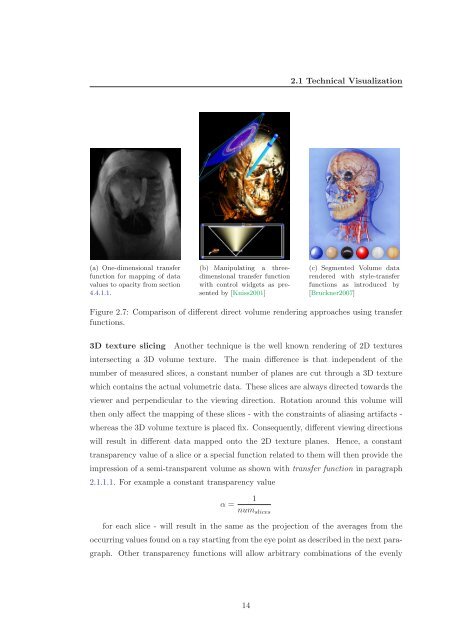Master's Thesis - Studierstube Augmented Reality Project - Graz ...
Master's Thesis - Studierstube Augmented Reality Project - Graz ...
Master's Thesis - Studierstube Augmented Reality Project - Graz ...
You also want an ePaper? Increase the reach of your titles
YUMPU automatically turns print PDFs into web optimized ePapers that Google loves.
2.1 Technical Visualization<br />
(a) One-dimensional transfer<br />
function for mapping of data<br />
values to opacity from section<br />
4.4.1.1.<br />
(b) Manipulating a threedimensional<br />
transfer function<br />
with control widgets as presented<br />
by [Kniss2001]<br />
(c) Segmented Volume data<br />
rendered with style-transfer<br />
functions as introduced by<br />
[Bruckner2007]<br />
Figure 2.7: Comparison of different direct volume rendering approaches using transfer<br />
functions.<br />
3D texture slicing Another technique is the well known rendering of 2D textures<br />
intersecting a 3D volume texture. The main difference is that independent of the<br />
number of measured slices, a constant number of planes are cut through a 3D texture<br />
which contains the actual volumetric data. These slices are always directed towards the<br />
viewer and perpendicular to the viewing direction. Rotation around this volume will<br />
then only affect the mapping of these slices - with the constraints of aliasing artifacts -<br />
whereas the 3D volume texture is placed fix. Consequently, different viewing directions<br />
will result in different data mapped onto the 2D texture planes. Hence, a constant<br />
transparency value of a slice or a special function related to them will then provide the<br />
impression of a semi-transparent volume as shown with transfer function in paragraph<br />
2.1.1.1. For example a constant transparency value<br />
α =<br />
1<br />
num slices<br />
for each slice - will result in the same as the projection of the averages from the<br />
occurring values found on a ray starting from the eye point as described in the next paragraph.<br />
Other transparency functions will allow arbitrary combinations of the evenly<br />
14





